Deserts Climate Type
by Devender
0 1492
Deserts are the regions with very little or no rainfall. The average rainfall is generally under 25 cm. The deserts can be hot like the Saharan desert, coastal dry deserts like Atacama & Temperate, or the mid-latitude deserts like the Gobi. Out of which, the hot desert climates are found below the subtropical ridge.
Deserts Climate Type
There is unbroken sunshine for the whole year, the air is stable and descending while there is high pressure aloft. These areas are located between 15 to 30 Degree south and north latitude, under the subtropical latitudes which are known as the horse latitudes. The major hot deserts of the world include –
- Sahara Desert (Africa)
- Thar Desert (India)
- Libyan Desert (Africa)
- Mojave Desert (N-America)
- Kalahari Desert (Africa)
- Iranian Desert
- Arabian Desert
- Gobi Desert
- Turkestan Desert
- Patagonian Desert
- Causes of aridity of deserts:
- Rain Shadow -
- Cold Ocean current -
- Continentality -
- Temperature variations in Deserts:
- The days in deserts are unbearably hot with a recorded high temperature of 76 Degree C in open barren
- Whereas, in shaded and well-ventilated areas such as Al-Azizia in Libya has the recorded high temperature of 58 Degree C
- These areas are much cooler than their latitude suggests
- Their average monthly temperatures are only 15 to 21 Degree C
- The airflow off adjacent coastal waters where the upwelling of the ocean gives rise to cold currents results in the cooling
- The deserts of this kind are subjected to frequent fog and low-level clouds
- However, these deserts are extremely arid
- Desert Facts:
- Northern Africa’s Sahara is the largest hot desert in the world
- Its temperature reaches 50* C during the daytime
- There are some deserts that are always cold such as the Gobi desert in Asia and the desert on the continent of Antarctica
- Simoom are the violent dust storms in deserts
- Desert Animals Characteristics:
- Some animals spend most of their time underground such as the desert tortoise in the southwestern US
- Most of the desert birds are nomadic, they crisscross the skies in search of food
- The desert animals are very vulnerable to introduced predators and changes in their habitat because of their very special adaptations
- Desert Vegetation Characteristics:
- The trees are very rare in deserts except for the places where there is enough groundwater to support the clusters of date palms
- The rate of decomposition is very low due to the absence of moisture
- Therefore, the soils of deserts lack humus content
- The high rate of evaporation makes the soil saline
- They develop an extensive root system close to the surface to collect more water during rainfall
- Some develop a deep root system to reach the groundwater
- Characteristics Features of desert vegetation:
- They poison their immediate neighbours to reduce the competition even from their own species
- They remain small to reduce the surface through which water can evaporate
- They get round for more advantageous ratio volume/surface
- They develop green cylindrical stems that can perform photosynthesis
- They cut off their limbs in order to reduce consumption of everything
- Nomads in Deserts:
- Minerals in Deserts:
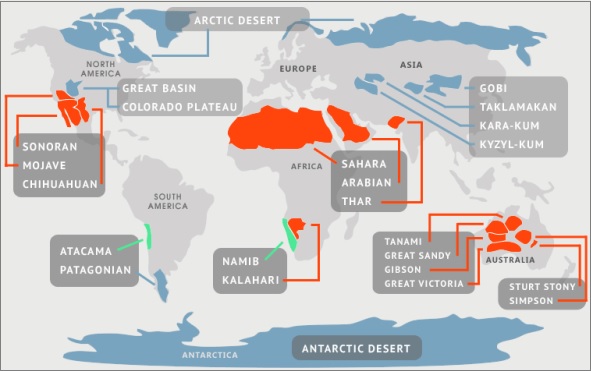
The cold oceanic currents diverting rain-laden air away from the coastlines result in hot desert drylands such as Atacama of Chile, the Namib of South Africa, and the western Australian desert. Many deserts are found on plateaus among the mid-latitude deserts. They are at a considerable distance from the sea and are known as Cold Deserts such as-
The hot deserts lie atop of the horse latitudes or subtropical high-pressure belts. The conditions are highly unfavourable for any kind of precipitation due to the presence of the air that is descending in nature.
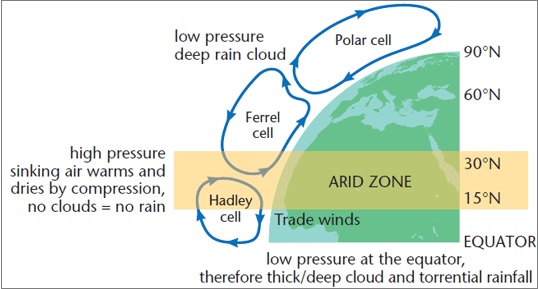
Compression warms and dries the air descending leeward side from the mountainous areas. It results in aridity and little rainfall. For example – the Patagonian desert due to the rain shadow effect of the Andes.

There is less evaporation of moisture as the cold air present above such currents ensures it. The result of this less evaporation is that it forms only fog and mist, and no clouds; hence, there is no rain. For Example – Atacama is the driest place on the earth because of the effect of the cold Peruvian current.
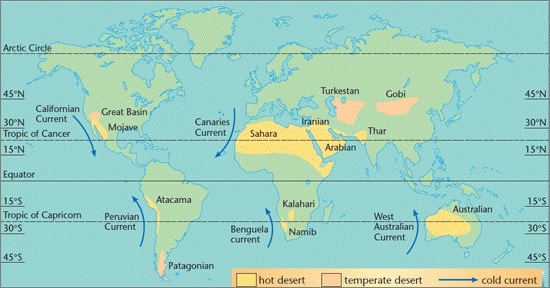
The central areas of the continents are generally dry because they lie far from the oceans and the air moving over the landmasses doesn’t absorb much water vapour that is required for precipitation.
The deserts are some of the hottest spots on the planet having high temperatures throughout the year with an average temperature around 30 to 35 Degree C. There are no cold seasons in hot deserts whereas the Diurnal range of temperature is extremely high in deserts because of high-temperature days and very cold nights.
The West Coast Desert areas are an interesting variant of tropical and subtropical deserts. These areas are found on the western coastal margins of the regions such as the Atacama deserts of South America, the Sahara (Moroccan part), and the Namib deserts of Africa.
1/5th of the earth's land is covered by deserts and they are present on every continent. Deserts are commonly referred to as hot and dry but there are cold deserts present in the world.
The animals living in deserts have adapted to ways to keep themselves cool and use less water. For example – Camels can go days without food and water. Many of the desert animals are nocturnal, they come out only when the brutal sun is down for hunting. These animals have long feet and secrete concentrated waste.
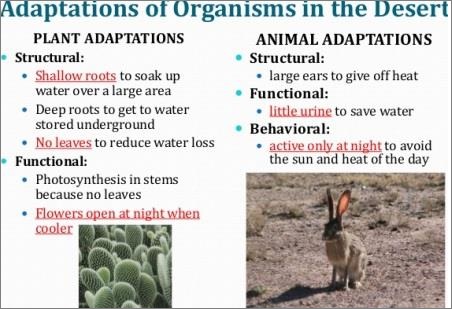
The vegetation in deserts is an amazing example of the adaptive powers of plants and trees. These majorly consist of scrub, herbs, weeds, roots, and bulbs. Xerophyte or drought-resistant is the predominant vegetation of deserts and they have special ways of storing and conserving water such as cacti.
The desert plants have very few or no leaves and the foliage is waxy, leathery, or hairy/needle-shaped as it helps in reducing the loss of water through transpiration. Their skin is tough and barks are thick to protect them from extensive evaporation.
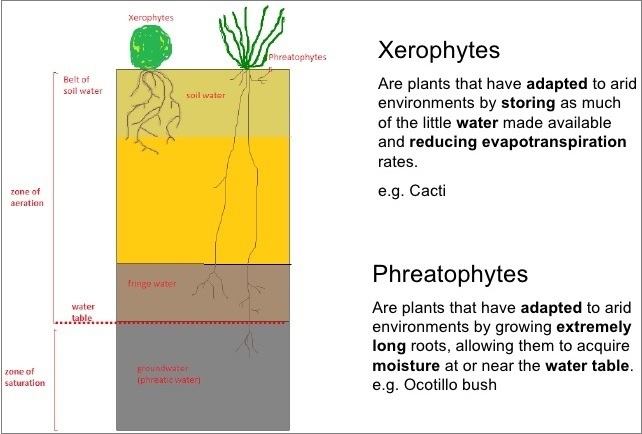
The vegetation in deserts lie dormant as seeds for many years and when there is enough rainfall, they speed up their active life to a 3-week compressed cycle during which they produce leaves, flowers, and new seeds in no time.
| Bushmen | Kalahari |
| Bindibu/Aborigins | Australia |
| Bedouin | Arabia |
| Tauregs | Sahara |
| Mangols | Gobi (Cold Desert) |
| Diamond & Copper | Kalahari (Thirst land) |
| Atacama | Caliche (Cemented gravels) -Sodium Nitrate fertilizer and Chuquicamata (Chile) - largest Copper town |
| Sahara & Arabia | Oil |
| Mexico | Silver |
| Utah | Uranium |
| Nevada | Copper |

Share:







Comments
Waiting for your comments